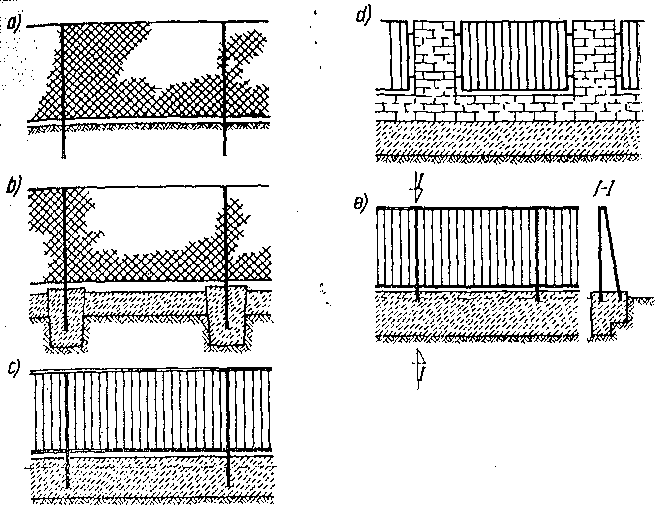The following elements may occur in the fences: poles, fillings (walls), foundations, plinths and buttresses as well as teams and wickets.
The poles designate the fence plane and hold the material forming the filling or the wall. The position of the poles should be accurate and durable. Placement of columns is usually 3 m and may change depending on the type of structure. Steel poles made of sections and pipes are most often used, brick stone brick poles, less often concrete and wooden poles. The poles can be founded separately or deposited in a uniform foundation running under the entire fence. The foundation depth is 60 – 100 cm and depends on the permeability of the ground and the freezing depth. Some fence constructions have no poles, If the wall is based or embedded in the foundation.
 More important types of fence structure: a) poles embedded directly in the ground, b) columns embedded in concrete and tile foundation under the mesh, c) poles embedded in a uniform foundation with a plinth, d) Masonry poles and plinths on a uniform concrete foundation, frame with a mesh hung on poles, e) Powelle fence - a wall made of steel flat bars based on a foundation and supported by the buttress.
More important types of fence structure: a) poles embedded directly in the ground, b) columns embedded in concrete and tile foundation under the mesh, c) poles embedded in a uniform foundation with a plinth, d) Masonry poles and plinths on a uniform concrete foundation, frame with a mesh hung on poles, e) Powelle fence - a wall made of steel flat bars based on a foundation and supported by the buttress.
The walls of the fence can be made of various materials. The most commonly used steel mesh attached to the poles or embedded in the framework between the columns. Often the wall is made up of steel sections or rods, boards, Various CDs, np. polyester, tin wavy. The walls can be made of prefabricated or brick brick elements, special blocks, decorative blocks and similar materials. The choice of the type of wall depends, among others, on the desired degree of clearance.